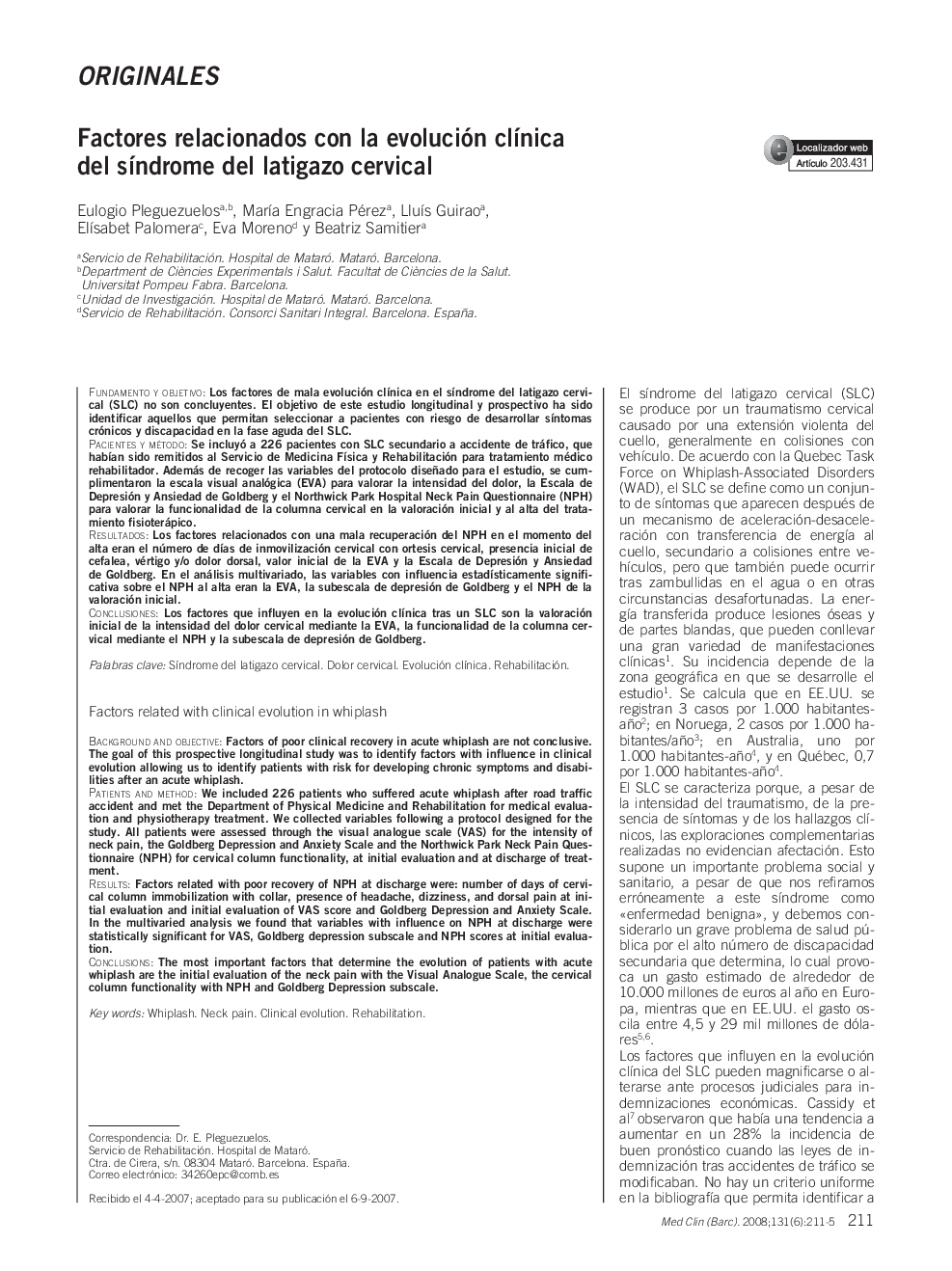| کد مقاله | کد نشریه | سال انتشار | مقاله انگلیسی | نسخه تمام متن |
|---|---|---|---|---|
| 3801375 | 1244720 | 2008 | 5 صفحه PDF | دانلود رایگان |

Fundamento y objetivoLOS factores de mala evolución clínica en el síndrome del latigazo cervical (SLC) no son concluyentes. El objetivo de este estudio longitudinal y prospectivo ha sido identificar aquellos que permitan seleccionar a pacientes con riesgo de desarrollar síntomas crónicos y discapacidad en la fase aguda del SLC.Pacientes y métodoSe incluyó a 226 pacientes con SLC secundario a accidente de tráfico, que habían sido remitidos al Servicio de Medicina Física y Rehabilitación para tratamiento médico rehabilitador. Además de recoger las variables del protocolo diseñado para el estudio, se cumplimentaron la escala visual analógica (EVA) para valorar la intensidad del dolor, la Escala de Depresión y Ansiedad de Goldberg y el Northwick Park Hospital Neck Pain Questionnaire (NPH) para valorar la funcionalidad de la columna cervical en la valoración inicial y al alta del tratamiento fisioterápico.ResultadosLOS factores relacionados con una mala recuperación del NPH en el momento del alta eran el número de días de inmovilización cervical con ortesis cervical, presencia inicial de cefalea, vértigo y/o dolor dorsal, valor inicial de la EVA y la Escala de Depresión y Ansiedad de Goldberg. En el análisis multivariado, las variables con influencia estadísticamente significativa sobre el NPH al alta eran la EVA, la subescala de depresión de Goldberg y el NPH de la valoración inicial.ConclusionesLOS factores que influyen en la evolución clínica tras un SLC son la valoración inicial de la intensidad del dolor cervical mediante la EVA, la funcionalidad de la columna cervical mediante el NPH y la subescala de depresión de Goldberg.
Background and objectiveFactors of poor clinical recovery in acute whiplash are not conclusive. The goal of this prospective longitudinal study was to identify factors with influence in clinical evolution allowing us to identify patients with risk for developing chronic symptoms and disabilities after an acute whiplash.Patients and methodWe included 226 patients who suffered acute whiplash after road traffic accident and met the Department of Physical Medicine and Rehabilitation for medical evaluation and physiotherapy treatment. We collected variables following a protocol designed for the study. All patients were assessed through the visual analogue scale (VAS) for the intensity of neck pain, the Goldberg Depression and Anxiety Scale and the Northwick Park Neck Pain Questionnaire (NPH) for cervical column functionality, at initial evaluation and at discharge of treatment.ResultsFactors related with poor recovery of NPH at discharge were: number of days of cervical column immobilization with collar, presence of headache, dizziness, and dorsal pain at initial evaluation and initial evaluation of VAS score and Goldberg Depression and Anxiety Scale. In the multivaried analysis we found that variables with influence on NPH at discharge were statistically significant for VAS, Goldberg depression subscale and NPH scores at initial evaluation.ConclusionsThe most important factors that determine the evolution of patients with acute whiplash are the initial evaluation of the neck pain with the Visual Analogue Scale, the cervical column functionality with NPH and Goldberg Depression subscale.
Journal: Medicina Clínica - Volume 131, Issue 6, July 2008, Pages 211–215